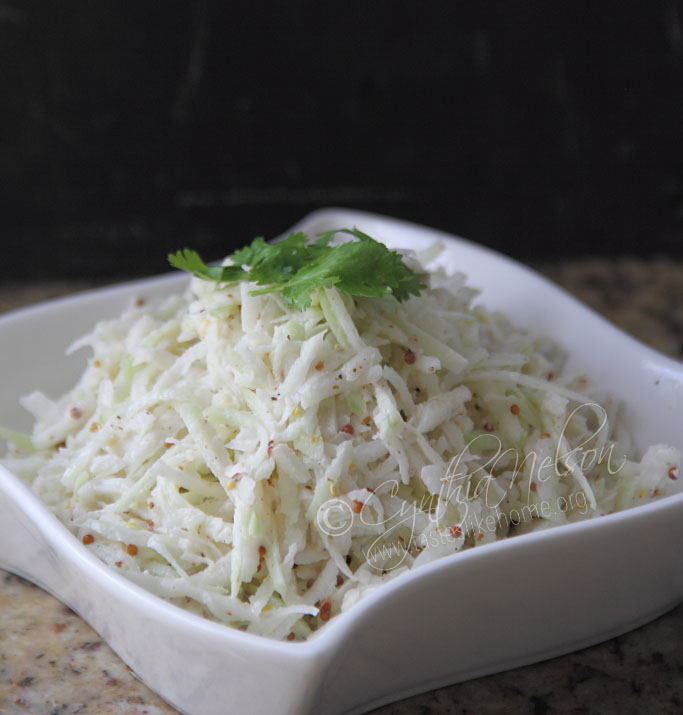 I am not new to kohlrabi. I first found out about it back in 2008 at the annual Agriculture Festival (Agrofest) that year. A former teacher turned farmer brought his harvest of the apple-green and purple bulbs to showcase what’s possible in expanding the country’s offering of vegetables. At the time, though not available in mainstream agriculture in Barbados, he was hoping to make the vegetable available to a niche market. Well, it still has not grown as part of the regular offering of vegetables, and as for the niche market, not much progress there either. I consider it a market find because for the past 2 weeks, I have seen kohlrabi at the market.
I am not new to kohlrabi. I first found out about it back in 2008 at the annual Agriculture Festival (Agrofest) that year. A former teacher turned farmer brought his harvest of the apple-green and purple bulbs to showcase what’s possible in expanding the country’s offering of vegetables. At the time, though not available in mainstream agriculture in Barbados, he was hoping to make the vegetable available to a niche market. Well, it still has not grown as part of the regular offering of vegetables, and as for the niche market, not much progress there either. I consider it a market find because for the past 2 weeks, I have seen kohlrabi at the market.
There is an old couple, retired, who garden and bring their offerings to the market to sell. You can always find something different at their stall albeit in small quantities. Finger squash, Bajan cucumbers (a particular variety), and frisée lettuce are among the things they bring to the market. Most of the time, they are the only ones with these items. I was delighted to see kohlrabi and bought a couple of pounds (that’s how they were selling them).

Kohlrabi belongs to the cabbage and broccoli family. It can be prepared and eaten raw or cooked. The leaves are also edible. You could cook them just like spinach/callaloo, only that they would take a little longer to cook. Steamed, sauteed, roasted, and stir-fried are all ways in which this vegetable can be prepared. It can be put into soups, stews and curries too. All those years ago when I first found it, I roasted it tossed with garlic and thyme. Not only did it take on the flavours of the ingredients with which it was seasoned but there was inherent sweetness that emerged with the method of cooking. I remember that I had also put it in dhal. The chunks provided bulk to the dhal and I ended up eating the dhal as a soup rather than with rice. I used it raw once when I shaved it thinly and mixed it with chunks of watermelon and mint to make a salad. It was lovely, offering crunch and texture to the salad. Served chilled, it was cooling and refreshing.
For the past 2 weeks, I have primarily been eating it raw as a slaw. And it is absolutely delicious. I dress it only with mayonnaise, whole mustard and freshly ground black pepper. It is crisp and crunchy. There are times when I have been eating it just by itself. It’s that good. One of the things about kohlrabi is that it takes on the flavour of whatever it is seasoned or dressed with; it absorbs, making itself tasty. You know what also, it does not become watery as some coleslaws do, particularly the one where salt or sugar is added. I cannot overstate how good kohlrabi slaw is.
Regardless of how you plan to cook it, remove the leaves and peel off the thick outer skin with a vegetable peeler, then proceed to chop, slice or grate it. Make it as a slaw by itself or with the other usual ingredients used to make coleslaw. Or you can replace the cabbage in the coleslaw with kohlrabi.
Next week, I want to make soup with it. I’ll sauté some aromatics before adding in chopped chunks of the kohlrabi, then equal amounts of broth and fresh coconut milk. Let it cook until tender and puree with an immersion blender. Can you imagine how creamy it will be? Yum!
Nutritionally, kohlrabi is low in calories, contains fibre and vitamin C.
Look out for kohlrabi and give it a try, particularly if you are living in the diaspora where you are likely to see it. And if you find it locally in the markets, well, you know what to do.
Have a great weekend everyone.
Cynthia









